Photo CD / DVD Transfer
$ 7.00
Photo CD is a system designed by Kodak for digitizing and saving photos onto a CD. Launched in 1991,[1] the discs were designed to hold nearly 100 high quality images, scanned prints and slides using special proprietary encoding. Photo CDs are defined in the Beige Book and conform to the CD-ROM XA and CD-i Bridge specifications as well. They were intended to play on CD-i players, Photo CD players (Apple's PowerCD for example), and any computer with a suitable software (LaserSoft Imaging's SilverFast DC or HDR for example).
The system failed to gain mass usage among consumers partly due to its proprietary nature, the rapidly decreasing scanner prices, and the lack of CD-ROM drives in most home personal computers of the day. Furthermore, Photo CD relied on CRT-based TV sets for home use. However, these were designed for moving pictures. Their typical flicker became an issue when watching still photographs. The Photo CD system gained a fair level of acceptance among professional photographers due to the low cost of the high quality film scans. Prior to Photo CD, professionals who wished to digitize their film images were forced to pay much higher fees to obtain drum scans of their film negatives and transparencies. Both JPEG[2] and JPEG 2000[3] support PhotoYCC colorspace as described below that is used in pcd files.
Ref: Wikipedia








Share this item: